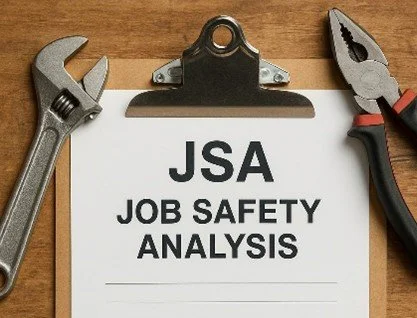JSA vs SWMS
Some people ask, “what is the difference between a Job Safety Analysis (JSA) and a Safe Work Method Statement (SWMS)”?
Background to the Terms
The term job safety analysis (JSA) has long been known and used in industry eg for over 90 years, as first defined by Heinrich in 1931.
Whereas the term safe work method statement (SWMS) only came into common use in the last decade or so, when the workplace safety regulations introduced the term SWMS and made a SWMS mandatory for high-risk construction work.
What is a JSA?
A JSA is a form of risk assessment eg task analysis, that details step-by-step the hazards, precautions, and how a task is to be carried out safely. Sometimes the JSA is called a JSEA and includes environmental aspects as well. The name does not matter.
What Should a JSA Contain?
Typically, JSAs have four main components, these include:
Basic Steps - A step-by-step list of the basic activities of the task eg load machine, startup process, run machine, clear blockages, and shut down process.
Hazards – List of potential hazards at each step of the task.
Control Measures - Step-by-step instructions on how to safely carry out the task by controlling each identified hazard eg the ‘DOs’.
Safety Precautions - Describe any safety precautions if the procedure doesn’t fully control the risks eg the ‘DON’Ts’.
Other than the employer’s general duty of care to have safe systems of work, the format and content of a JSA is not prescribed, so you can vary it if desired.
Click here to download our free JSA Template.
It’s ready to use so you don’t have to create one from scratch.
What is a SWMS?
A SWMS lists the hazards and controls for a task and therefore indirectly details, step-by-step, how a task is to be carried out safely.
The difference between a JSA and a SWMS is that SWMS are prescribed for all High-Risk Construction Work (HRCW) under the workplace safety regulations in each state and territory of Australia.
Whereas JSAs may form part of your safe system of work, but the format and content is not prescribed. Alternatives could include safe work procedures (SWP) or standard operating procedure (SOP).
What is High-Risk Construction Work?
There are 19 prescribed high risk construction activities / equipment that must have a SWMS to operate. For example; crane operation, scaffolding, trenching, working at height, electrical work or asbestos work etc. The full list is outlined in each jurisdiction’s heath and safety regulations.
What Should a SWMS Contain?
The regulations require a SWMS to:
Name the HRCW involved eg work at height, and
Identify the hazards associated with the task.
Describe the controls for each hazard and how they are to be implemented.
Be simple eg set out and expressed in a way that is comprehensible to the users.
Format for a SWMS
We suggest you format your SWMS to have three main components:
Basic Steps - Break the task into basic steps.
Key Hazards - List the key hazards at each step of the task.
Key Controls - Controls and how the control measures are to be implemented.
Each SWMS should be short, succinct and easy to understand. Ideally, it should fit on one page, or one page double-sided.
Click here to download our SWMS Template
It’s ready to use so you don’t have to create one from scratch.
Additional Duties for SWMS in Construction
Employers must ensure the SWMS for HRCW is complied with.
If the task or conditions change, the work must immediately STOP and the SWMS should be reviewed and updated.
SMWS are to be kept for the duration of the task, and under WHS regulations
SWMS must also be given to the Principal Contractor before work commences.
What is NOT Legally Required in a SWMS?
The regulations do not prescribe the format of a SWMS and surprisingly, many details commonly seen on SWMS, are also not legally required.
Whilst companies may choose to include additional information on their SWMS, safety laws do NOT mandate things like:
List of legislation or codes,
Consultation details,
Training records,
Worker’s sign-off,
Risk assessment matrix or rating
Unnecessary details can distract from the SWMS's primary purpose, which is to identify and control the hazards.
Beware of fanatics trying to enforce specific formats or content for JSAs or SWMSs.
If you’re unsure how much detail you should include in your SWMS, read our article ‘Evil SWMS - The Devil Is In Too Much Detail’.
Use of SWMS and JSA Outside of Construction
The use of the term ‘SWMS’ has increasingly been used outside of construction work and outside of high risk construction (HRCW), and this is where some confusion has arisen.
Your business may call these documents whatever you like, as long as HRCW has a compliant SWMS.
Summary
If your process identifies all the hazards and outlines how they will be controlled during the task, then you have satisfied the minimum legal requirement eg to provide a ‘safe system of work’, whether called a JSA or SWMS.
If interested in more information on this topic visit How To Prepare an Effective SWMS – A short video by Gary Rowe.



